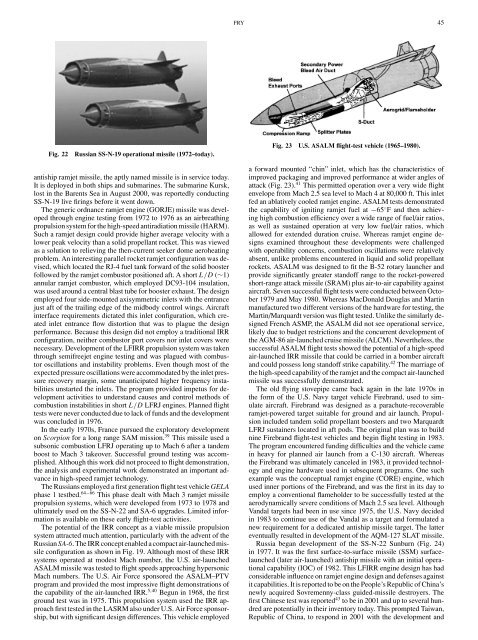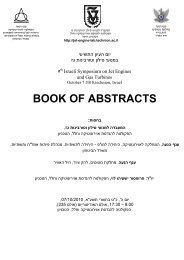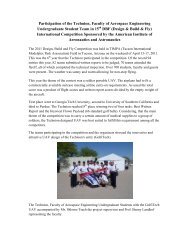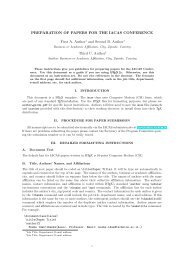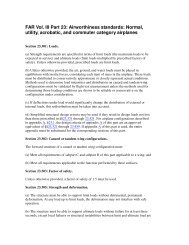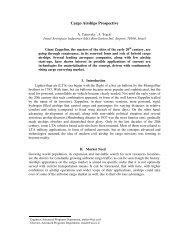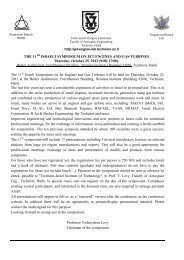A Century of Ramjet Propulsion Technology Evolution - Faculty of ...
A Century of Ramjet Propulsion Technology Evolution - Faculty of ...
A Century of Ramjet Propulsion Technology Evolution - Faculty of ...
Create successful ePaper yourself
Turn your PDF publications into a flip-book with our unique Google optimized e-Paper software.
Fig. 22 Russian SS-N-19 operational missile (1972–today).<br />
antiship ramjet missile, the aptly named missile is in service today.<br />
It is deployed in both ships and submarines. The submarine Kursk,<br />
lost in the Barents Sea in August 2000, was reportedly conducting<br />
SS-N-19 live firings before it went down.<br />
The generic ordnance ramjet engine (GORJE) missile was developed<br />
through engine testing from 1972 to 1976 as an airbreathing<br />
propulsion system for the high-speed antiradiation missile (HARM).<br />
Such a ramjet design could provide higher average velocity with a<br />
lower peak velocity than a solid propellant rocket. This was viewed<br />
as a solution to relieving the then-current seeker dome aeroheating<br />
problem. An interesting parallel rocket ramjet configuration was devised,<br />
which located the RJ-4 fuel tank forward <strong>of</strong> the solid booster<br />
followed by the ramjet combustor positioned aft. A short L/D (∼1)<br />
annular ramjet combustor, which employed DC93-104 insulation,<br />
was used around a central blast tube for booster exhaust. The design<br />
employed four side-mounted axisymmetric inlets with the entrance<br />
just aft <strong>of</strong> the trailing edge <strong>of</strong> the midbody control wings. Aircraft<br />
interface requirements dictated this inlet configuration, which created<br />
inlet entrance flow distortion that was to plague the design<br />
performance. Because this design did not employ a traditional IRR<br />
configuration, neither combustor port covers nor inlet covers were<br />
necessary. Development <strong>of</strong> the LFIRR propulsion system was taken<br />
through semifreejet engine testing and was plagued with combustor<br />
oscillations and instability problems. Even though most <strong>of</strong> the<br />
expected pressure oscillations were accommodated by the inlet pressure<br />
recovery margin, some unanticipated higher frequency instabilities<br />
unstarted the inlets. The program provided impetus for development<br />
activities to understand causes and control methods <strong>of</strong><br />
combustion instabilities in short L/D LFRJ engines. Planned flight<br />
tests were never conducted due to lack <strong>of</strong> funds and the development<br />
was concluded in 1976.<br />
In the early 1970s, France pursued the exploratory development<br />
on Scorpion for a long range SAM mission. 39 This missile used a<br />
subsonic combustion LFRJ operating up to Mach 6 after a tandem<br />
boost to Mach 3 takeover. Successful ground testing was accomplished.<br />
Although this work did not proceed to flight demonstration,<br />
the analysis and experimental work demonstrated an important advance<br />
in high-speed ramjet technology.<br />
The Russians employed a first generation flight test vehicle GELA<br />
phase 1 testbed. 64−66 This phase dealt with Mach 3 ramjet missile<br />
propulsion systems, which were developed from 1973 to 1978 and<br />
ultimately used on the SS-N-22 and SA-6 upgrades. Limited information<br />
is available on these early flight-test activities.<br />
The potential <strong>of</strong> the IRR concept as a viable missile propulsion<br />
system attracted much attention, particularly with the advent <strong>of</strong> the<br />
Russian SA-6. The IRR concept enabled a compact air-launched missile<br />
configuration as shown in Fig. 19. Although most <strong>of</strong> these IRR<br />
systems operated at modest Mach number, the U.S. air-launched<br />
ASALM missile was tested to flight speeds approaching hypersonic<br />
Mach numbers. The U.S. Air Force sponsored the ASALM–PTV<br />
program and provided the most impressive flight demonstrations <strong>of</strong><br />
the capability <strong>of</strong> the air-launched IRR. 5,40 Begun in 1968, the first<br />
ground test was in 1975. This propulsion system used the IRR approach<br />
first tested in the LASRM also under U.S. Air Force sponsorship,<br />
but with significant design differences. This vehicle employed<br />
FRY 45<br />
Fig. 23 U.S. ASALM flight-test vehicle (1965–1980).<br />
a forward mounted “chin” inlet, which has the characteristics <strong>of</strong><br />
improved packaging and improved performance at wider angles <strong>of</strong><br />
attack (Fig. 23). 41 This permitted operation over a very wide flight<br />
envelope from Mach 2.5 sea level to Mach 4 at 80,000 ft. This inlet<br />
fed an ablatively cooled ramjet engine. ASALM tests demonstrated<br />
the capability <strong>of</strong> igniting ramjet fuel at −65 ◦ F and then achieving<br />
high combustion efficiency over a wide range <strong>of</strong> fuel/air ratios,<br />
as well as sustained operation at very low fuel/air ratios, which<br />
allowed for extended duration cruise. Whereas ramjet engine designs<br />
examined throughout these developments were challenged<br />
with operability concerns, combustion oscillations were relatively<br />
absent, unlike problems encountered in liquid and solid propellant<br />
rockets. ASALM was designed to fit the B-52 rotary launcher and<br />
provide significantly greater stand<strong>of</strong>f range to the rocket-powered<br />
short-range attack missile (SRAM) plus air-to-air capability against<br />
aircraft. Seven successful flight tests were conducted between October<br />
1979 and May 1980. Whereas MacDonald Douglas and Martin<br />
manufactured two different versions <strong>of</strong> the hardware for testing, the<br />
Martin/Marquardt version was flight tested. Unlike the similarly designed<br />
French ASMP, the ASALM did not see operational service,<br />
likely due to budget restrictions and the concurrent development <strong>of</strong><br />
the AGM-86 air-launched cruise missile (ALCM). Nevertheless, the<br />
successful ASALM flight tests showed the potential <strong>of</strong> a high-speed<br />
air-launched IRR missile that could be carried in a bomber aircraft<br />
and could possess long stand<strong>of</strong>f strike capability. 42 The marriage <strong>of</strong><br />
the high-speed capability <strong>of</strong> the ramjet and the compact air-launched<br />
missile was successfully demonstrated.<br />
The old flying stovepipe came back again in the late 1970s in<br />
the form <strong>of</strong> the U.S. Navy target vehicle Firebrand, used to simulate<br />
aircraft. Firebrand was designed as a parachute-recoverable<br />
ramjet-powered target suitable for ground and air launch. <strong>Propulsion</strong><br />
included tandem solid propellant boosters and two Marquardt<br />
LFRJ sustainers located in aft pods. The original plan was to build<br />
nine Firebrand flight-test vehicles and begin flight testing in 1983.<br />
The program encountered funding difficulties and the vehicle came<br />
in heavy for planned air launch from a C-130 aircraft. Whereas<br />
the Firebrand was ultimately canceled in 1983, it provided technology<br />
and engine hardware used in subsequent programs. One such<br />
example was the conceptual ramjet engine (CORE) engine, which<br />
used inner portions <strong>of</strong> the Firebrand, and was the first in its day to<br />
employ a conventional flameholder to be successfully tested at the<br />
aerodynamically severe conditions <strong>of</strong> Mach 2.5 sea level. Although<br />
Vandal targets had been in use since 1975, the U.S. Navy decided<br />
in 1983 to continue use <strong>of</strong> the Vandal as a target and formulated a<br />
new requirement for a dedicated antiship missile target. The latter<br />
eventually resulted in development <strong>of</strong> the AQM-127 SLAT missile.<br />
Russia began development <strong>of</strong> the SS-N-22 Sunburn (Fig. 24)<br />
in 1977. It was the first surface-to-surface missile (SSM) surfacelaunched<br />
(later air-launched) antiship missile with an initial operational<br />
capability (IOC) <strong>of</strong> 1982. This LFIRR engine design has had<br />
considerable influence on ramjet engine design and defenses against<br />
it capabilities. It is reported to be on the People’s Republic <strong>of</strong> China’s<br />
newly acquired Sovremenny-class guided-missile destroyers. The<br />
first Chinese test was reported 43 to be in 2001 and up to several hundred<br />
are potentially in their inventory today. This prompted Taiwan,<br />
Republic <strong>of</strong> China, to respond in 2001 with the development and


